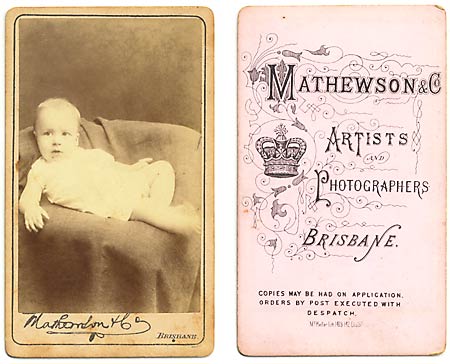Marking time in November 2002
Whale on the menu
IKEDA, Osaka — Children at public elementary schools in Ikeda will be feed [sic] whale meat with their school lunches for the first time in 23 years, education officials said Saturday. [From the online Mainichi Daily News today.]
From other headlines I gather this is a newspaper with a specific range of interests. The twelve big stories today include a fatal knifing, a fatal car crash, torture of a schoolgirl, a captive teen sex slave, discovery of three skeletons, a child molesting cop, offensive actions by a business man towards a schoolgirl on an escalator, and (see above) whale meat.
A collection of cartes-de-visite
Instead of sitting in a rustic chair in the company of birds I have spent a little time scanning Queensland carte-de-visite photographs so you can see them here.
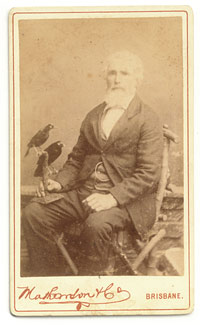
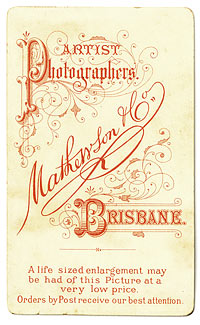
First birthday
I began marking time on this day a year ago. I give thanks for the protection of Thomas, patron saint of architects. We need a patron saint for bloggers.
Photography in street and studio
See Street and studio: popular commercial photography in India and Bangladesh, an article from the online journal Intersections: gender, history and culture in the Asian context. It deconstructs the kind of photography that producted one of my own mugshots.
Rock art under threat
Robert Bednarik has published this web page about the threatened destruction of a rich collection of Indigenous rock art in north-western Australia:
In an unprecedented decision, unique in the legal history of Australia, the National Native Title Tribunal (NNTT) has on 9 November 2002 called for public submissions for a case currently before it. It is the extraordinary case of the Western Australian government versus the Aboriginal communities in the Dampier region. The case deals with the land on which the Dampier Rock Art Precinct, the largest concentration of petroglyphs known in the world, occurs. In response to IFRAO’s proposal that this constitutes a world heritage property, the NNTT has recognised that there is a major public interest component involved and, in the face of vigorous protests by the government, has ruled that it wishes to receive public submissions on the matter.
![Murujuga petroglyphs [image from Robert Bednarik's web page]](images/burrupPetroglyphs.jpg)
Eco-fur
I’m grateful to Richard for pointing out this item about using alien possums as an economic resource. I’ll quote from the New Zealand Nature Co website:
Introduced into New Zealand about 150 years ago from Australia, the brushtail possum has multiplied now to over 70,000,000. With no predators, this pest has decimated huge tracts of New Zealand native forests eating 21,000 tons of vegetation nightly.The brushtail possum has a fur similar in quality to mink and colours range from silver to red brown to dark brown. Preservation of New Zealand Native Forests requires control of the possum population. All controls used in the past have had minimum impact. Poisoning of possums is an environmentally unacceptable way of control. Only through world wide marketing of possum fur products (Eco-fur products ) can this pest be safely controlled. Our Eco Fur products are all of the highest professional standards.
I live in the brushtail possum’s native country, and there are times I would happily join the possum fur trade. A couple of them are dossing in my workshop right now, chucking things off the shelves, and worse. And here’s one that fell down the chimney and got trapped in the space above the wood stove in the kitchen — to find out what was making the scratching noises, I dismantled the stove flue and stuck a camera up the hole:
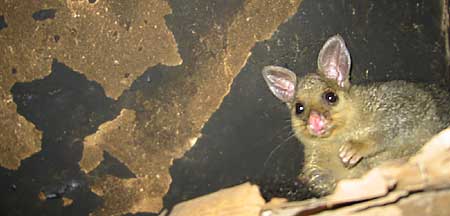
<irony>
It’s wonderful to live so close to nature.
</irony>
I won’t mention what the scrub turkeys are doing to the vegetable garden. Grumble, grumble….
The wooden library
The Swedish University of Agricultural Sciences maintains the Alnarp Library, which specialises in horticulture and landscape planning. Its collection includes a wooden library. I’ll quote from the library’s website:
![Books from the wooden library [image from the university website]](images/woodbooks.jpg)
The wooden library, or xylothek (from the Greek words for tree, xylon, and storing place, theke) consists of 217 volumes describing 213 different species or varieties of trees and shrubs.
A xylothek is generally speaking a collection of simple pieces of wood specimens placed together in some kind of cupboard. In a refined form it is in the shape of “books” where you can find details from the tree inside, everything arranged as a “library”. This latter form flourished in Germany around 1790-1810. Four different manufacturers existed and three of them offered their products for sale. The Alnarp collection is an example of that.
Each “book” describes a certain tree species and is made out of the actual wood (the “covers”). The spine is covered by the bark, where mosses and lichens from the same tree are arranged. “Books” of shrubs are covered with mosses with split branches on both covers and spines.
Inside there are dried leaves, flowers, fruits, seedlings, a piece of the root, cut branches, seeds - similarly organised in every “book”. Inside the spine there is a very nicely written description of the biology of the tree species and also a description of how to use it practically.
![An open book showing the contents [image from the university website]](images/woodbookopen.jpg)
Credits: I am grateful to Craig in the USA for this link. He got it from Mark in Canada, who got it from Tinka in Denmark.
Conserving photographs
I spent today at a photographic preservation workshop, looking closely at daguerreotypes, tintypes, ambrotypes and other early photographs, and learning how to care for them. Thanks to Lydia Egunnike, conservator at the State Library of Queensland, for an excellent session. My little collection is in for some tender loving care.
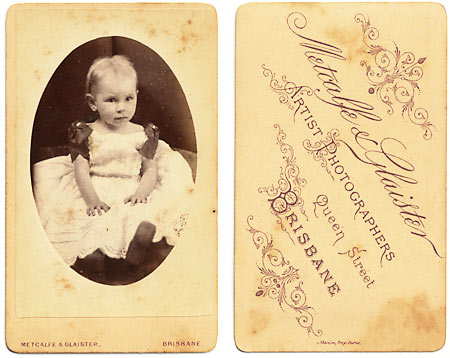
A few months ago the photographic historian Marcel Safier pointed out to me that my ancestor Daniel Marquis operated a photographic studio in Brisbane from 1866. I regret that I don’t have any examples of Daniel’s work.
When Daniel died in 1879 his business was taken over by D F Metcalfe and renamed the Imperial Photo Company (late D Marquis). The picture above comes from a studio that Metcalfe operated before then. It is a carte-de-visite — a nicely lithographed card, 63mm x 105mm, with an albumen print pasted on. Such visiting card photos were immensely popular in the late nineteenth century.
Mass-market photography started with the carte-de-visite craze. I have been quietly collecting these little reminders of ordinary life, and enjoying their subjects, their design, and their connection with the photographers who made them. 